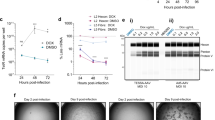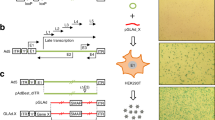Abstract
Fully deleted adenovirus vectors (FD-AdVs) would appear to be promising tools for gene therapy. Since these vectors are deleted of all adenoviral genes, they require a helper adenovirus for their propagation. The contamination of the vector preparation by the helper limits the utility of currently existing FD-AdVs in gene therapy applications. We have developed an alternative system for the propagation of FD-AdVs, in which the adenoviral genes essential for replication and packaging of the vector are delivered into producer cells by a baculovirus–adenovirus hybrid. A hybrid baculovirus Bac-B4 was constructed to carry a Cre recombinase-excisable copy of the packaging-deficient adenovirus genome. Although the total size of the DNA insert in Bac-B4 was 38 kb, the genetic structure of this recombinant baculovirus was stable. Bac-B4 gave high yields in Sf9 insect cells, with titers of 5 × 108p.f.u./ml before concentration. Transfection of 293-Cre cells with lacZ-expressing FD-AdV plasmid DNA followed by infection by Bac-B4 at a MOI of 2000 p.f.u./ml resulted in rescue of the helper-free vector. Subsequent passaging of the obtained FD-AdV using Bac-B4 as a helper resulted in ∼100-fold increases of the vector titer at each passage. This resulting vector was completely free of helper virus and was able to transduce cultured 293 cells. However, scaling-up of FD-AdV production was prevented by the eventual emergence of replication-competent adenovirus (RCA). Experiments are underway to optimize this system for the large-scale production of helper virus-free FD-AdVs and to minimize the possibility of generation of replication-competent adenovirus (RCA) during vector production. This baculovirus-based system will be a very useful alternative to current methods for the production of FD-AdVs.
This is a preview of subscription content, access via your institution
Access options
Subscribe to this journal
Receive 12 print issues and online access
$259.00 per year
only $21.58 per issue
Buy this article
- Purchase on Springer Link
- Instant access to full article PDF
Prices may be subject to local taxes which are calculated during checkout






Similar content being viewed by others
References
Mullbacher A, Bellett AJ, Hla RT . The murine cellular immune response to adenovirus type 5 Immunol Cell Biol 1989 67: 31–39
Yang Y, Ertl HC, Wilson JM . MHC class I-restricted cytotoxic T lymphocytes to viral antigens destroy hepatocytes in mice infected with E1-deleted recombinant adenoviruses Immunity 1994 1: 433–442
Yang Y et al. Cellular immunity to viral antigens limits E1-deleted adenoviruses for gene therapy Proc Natl Acad Sci USA 1994 91: 4407–4411
Juillard V et al. Long-term humoral and cellular immunity induced by a single immunization with replication-defective adenovirus recombinant vector Eur J Immunol 1995 25: 3467–3473
Yang Y et al. Inactivation of E2a in recombinant adenoviruses improves the prospect for gene therapy in cystic fibrosis Nat Genet 1994 7: 362–369
Engelhardt JF, Ye X, Doranz B, Wilson JM . Ablation of E2A in recombinant adenoviruses improves transgene persistence and decreases inflammatory response in mouse liver Proc Natl Acad Sci USA 1994 91: 6196–6200
Armentano D et al. Characterization of an adenovirus gene transfer vector containing an E4 deletion Hum Gene Ther 1995 6: 1343–1353
Krougliak V, Graham FL . Development of cell lines capable of complementing E1, E4, and protein IX defective adenovirus type 5 mutants Hum Gene Ther 1995 6: 1575–1586
Wang Q, Jia XC, Finer MH . A packaging cell line for propagation of recombinant adenovirus vectors containing two lethal gene-region deletions Gene Therapy 1995 2: 775–783
Fang B et al. Lack of persistence of E1- recombinant adenoviral vectors containing a temperature-sensitive E2A mutation in immunocompetent mice and hemophilia B dogs Gene Therapy 1996 3: 217–222
Gorziglia MI et al. Elimination of both E1 and E2 from adenovirus vectors further improves prospects for in vivo human gene therapy J Virol 1996 70: 4173–4178
Wang Q et al. Persistent transgene expression in mouse liver following in vivo gene transfer with a delta E1/delta E4 adenovirus vector Gene Therapy 1997 4: 393–400
Amalfitano A et al. Production and characterization of improved adenovirus vectors with the E1, E2b, and E3 genes deleted J Virol 1998 72: 926–933
Hartigan-O'Connor D, Amalfitano A, Chamberlain JS . Improved production of gutted adenovirus in cells expressing adenovirus preterminal protein and DNA polymerase J Virol 1999 73: 7835–7841
Mitani K, Graham FL, Caskey CT, Kochanek S . Rescue, propagation, and partial purification of a helper virus- dependent adenovirus vector Proc Natl Acad Sci USA 1995 92: 3854–3858
Fisher KJ et al. Recombinant adenovirus deleted of all viral genes for gene therapy of cystic fibrosis Virology 1996 217: 11–22
Kochanek S et al. A new adenoviral vector: Replacement of all viral coding sequences with 28 kb of DNA independently expressing both full-length dystrophin and beta-galactosidase Proc Natl Acad Sci USA 1996 93: 5731–5736
Lieber A, He CY, Kirillova I, Kay MA . Recombinant adenoviruses with large deletions generated by Cre- mediatedexcision exhibit different biological properties compared withfirst-generation vectors in vitro and in vivo J Virol 1996 70: 8944–8960
Parks RJ et al. A helper-dependent adenovirus vector system: removal of helper virus by Cre-mediated excision of the viral packaging signal Proc Natl Acad Sci USA 1996 93: 13565–13570
Parks RJ, Graham FL . A helper-dependent system for adenovirus vector production helps define a lower limit for efficient DNA packaging J Virol 1997 71: 3293–3298
Schiedner G et al. Genomic DNA transfer with a high-capacity adenovirus vector results in improved in vivo gene expression and decreased toxicity published erratum appears in Nat Genet 1998 Mar;18(3): 298) Nat Genet 1998 18: 180–183
Morsy MA et al. An adenoviral vector deleted for all viral coding sequences results in enhanced safety and extended expression of a leptin transgene Proc Natl Acad Sci USA 1998 95: 7866–7871
Parks RJ et al. Effects of stuffer DNA on transgene expression from helper-dependent adenovirus vectors J Virol 1999 73: 8027–8034
Morral N et al. Administration of helper-dependent adenoviral vectors and sequential delivery of different vector serotype for long-term liver-directed gene transfer in baboons Proc Natl Acad Sci USA 1999 96: 12816–12821
Morsy MA, Caskey CT . Expanded-capacity adenoviral vectors – the helper-dependent vectors Mol Med Today 1999 5: 18–24
Sandig V et al. Optimization of the helper-dependent adenovirus system for production and potency in vivo Proc Natl Acad Sci USA 2000 97: 1002–1007
Hofmann C et al. Efficient gene transfer into human hepatocytes by baculovirus vectors Proc Natl Acad Sci USA 1995 92: 10099–10103
Boyce FM, Bucher NL . Baculovirus-mediated gene transfer into mammalian cells Proc Natl Acad Sci USA 1996 93: 2348–2352
Sandig V et al. Gene transfer into hepatocytes and human liver tissue by baculovirus vectors Hum Gene Ther 1996 7: 1937–1945
Graham FL . Covalently closed circles of human adenovirus DNA are infectious EMBO J 1984 3: 2917–2922
McGrory WJ, Bautista DS, Graham FL . A simple technique for the rescue of early region I mutations into infectious human adenovirus type 5 Virology 1988 163: 614–617
Sauer B, Henderson N . The cyclization of linear DNA in Escherichia coli by site-specific recombination Gene 1988 70: 331–341
Sternberg N . Bacteriophage P1 cloning system for the isolation, amplification, and recovery of DNA fragments as large as 100 kilobase pairs Proc Natl Acad Sci USA 1990 87: 103–107
Groner A, Granados RR, Burand JP . Interaction of Autographa californica nuclear polyhedrosis virus with two nonpermissive cell lines Intervirology 1984 21: 203–209
Carbonell LF, Miller LK . Baculovirus interaction with nontarget organisms: a virus-borne reporter gene is not expressed in two mammalian cell lines Appl Environ Microbiol 1987 53: 1412–1417
Hartig PC, Chapman MA, Hatch GG, Kawanishi CY . Insect virus: assays for toxic effects and transformation potential in mammalian cells Appl Environ Microbiol 1989 55: 1916–1920
Hartig PC, Cardon MC, Kawanishi CY . Insect virus: assays for viral replication and persistence in mammalian cells J Virol Meth 1991 31: 335–344
Hartig PC, Cardon MC, Kawanishi CY . Effect of baculovirus on selected vertebrate cells Dev Biol Stand 1992 76: 313–317
Bett AJ, Haddara W, Prevec L, Graham FL . An efficient and flexible system for construction of adenovirus vectors with insertions or deletions in early regions 1 and 3 Proc Natl Acad Sci USA 1994 91: 8802–8806
Barsoum J, Brown R, McKee M, Boyce FM . Efficient transduction of mammalian cells by a recombinant baculovirus having the vesicular stomatitis virus G glycoprotein Hum Gene Ther 1997 8: 2011–2018
DiLella AG et al. Molecular structure and polymorphic map of the human phenylalanine hydroxylase gene Biochemistry 1986 25: 743–749
Ayres MD et al. The complete DNA sequence of Autographa californica nuclear polyhedrosis virus Virology 1994 202: 586–605
Barsoum J . Concentration of recombinant baculovirus by cation-exchange chromatography Biotechniques 1999 26: 834–840
Guo ZS, Wang LH, Eisensmith RC, Woo SL . Evaluation of promoter strength for hepatic gene expression in vivo following adenovirus-mediated gene transfer Gene Therapy 1996 3: 802–810
Berkner KL, Sharp PA . Generation of adenovirus by transfection of plasmids Nucleic Acids Res 1983 11: 6003–6020
Lippe R, Graham FL . Adenoviruses with nonidentical terminal sequences are viable J Virol 1989 63: 5133–5141
O'Reilly DR . Use of baculovirus expression vectors Meth Mol Biol 1997 62: 235–246
Graham FL, Prevec L . Methods for construction of adenovirus vectors Mol Biotechnol 1995 3: 207–220
Acknowledgements
This work was supported by NIH grants DK51700 to RCE and DK5333 to VAK.
Author information
Authors and Affiliations
Rights and permissions
About this article
Cite this article
Cheshenko, N., Krougliak, N., Eisensmith, R. et al. A novel system for the production of fully deleted adenovirus vectors that does not require helper adenovirus. Gene Ther 8, 846–854 (2001). https://doi.org/10.1038/sj.gt.3301459
Received:
Accepted:
Published:
Issue Date:
DOI: https://doi.org/10.1038/sj.gt.3301459
Keywords
This article is cited by
-
Solutions against emerging infectious and noninfectious human diseases through the application of baculovirus technologies
Applied Microbiology and Biotechnology (2021)
-
Improving Baculovirus Transduction of Mammalian Cells by Incorporation of Thogotovirus Glycoproteins
Virologica Sinica (2019)
-
Construction of a highly efficient display system for baculovirus and its application on multigene co-display
Molecular Genetics and Genomics (2018)
-
Recent advances in live cell imaging of hepatoma cells
BMC Cell Biology (2014)
-
Efficient gene delivery into cell lines and stem cells using baculovirus
Nature Protocols (2014)



